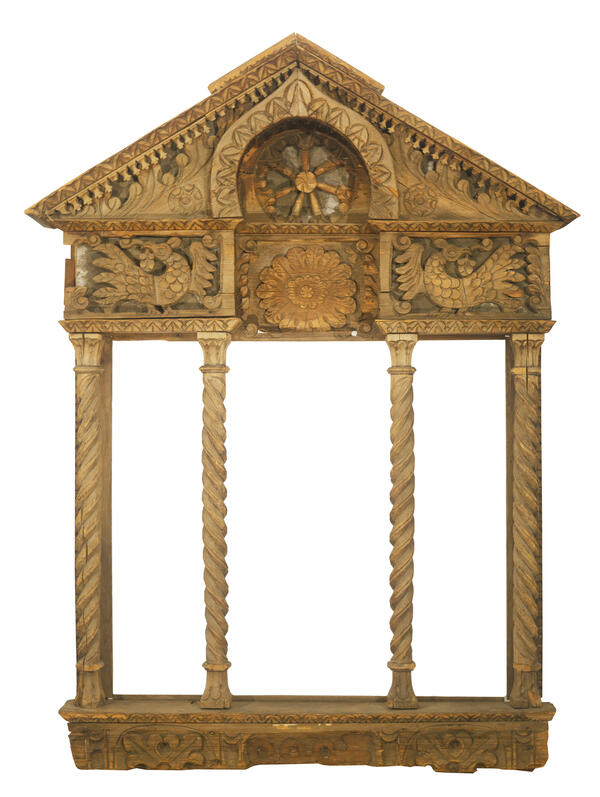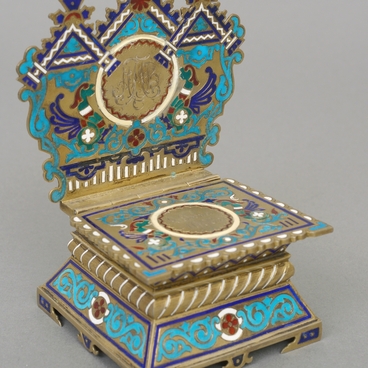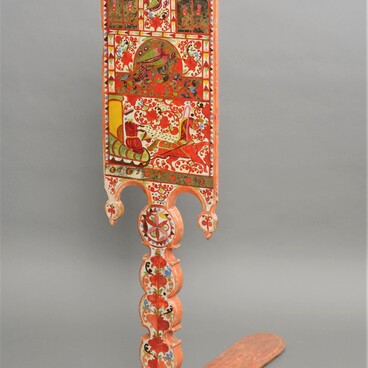The tradition of decorating houses with woodcarving and window dressings dates to ancient pagan times, when people endowed a variety of objects with miraculous magical properties.
Special attention was paid to decorating the outside of the house. First, the front side of the house was decorated, especially the windows. Window dressings turned into charms to protect the home from evil spirits, and they were also decorated with patterns that were supposed to help “lure” well-being into the house, to appease the forces of nature: fertility, sun and rain.
The exposition presents the carved window dressing of the attic, created in Volga region. The Volga region woodcarving was known throughout Russia. One of its names is shipborn. In the 19th century, the Volga region was a place where art, crafts and trade flourished. Up to five thousand wooden ships passed along the Volga every year, many of which were decorated with carvings.
Middle Volga region was the main area of shipbuilding and ship carving. Many carpenters and carvers from various provinces of the Russian Empire flocked to the villages on the banks of the Volga. When the work at the shipyards stopped in the spring, carpenters — shipbuilders were engaged in agriculture and took orders for decorating huts with relief carvings.
Attic dressings had their own characteristics. They decorated the window under the very roof of the house. The peasants expanded the living area at the expense of the upper floor, where the lights were arranged. There were more windows in such a room than in others. They were most often arranged in the female half of the house, where the needlework was usually performed.
The shape of the attic dressing usually repeated the facade of the building in miniature, with a classic triangular pediment and frieze at the top, resting on twisted columns, which, in turn, are supported by a rectangular base of the dressing. The dressing is richly decorated with relief carvings — one can see images of the sun, flowers, birds — these are traditional images of Russian arts and crafts.
In the Volga region, the “fashion” for attic dressings became so widespread that they were used to decorate the house, regardless of the actual presence of an attic and a large window. For example, sometimes such a dressing adorned a small “dormer” window.
Special attention was paid to decorating the outside of the house. First, the front side of the house was decorated, especially the windows. Window dressings turned into charms to protect the home from evil spirits, and they were also decorated with patterns that were supposed to help “lure” well-being into the house, to appease the forces of nature: fertility, sun and rain.
The exposition presents the carved window dressing of the attic, created in Volga region. The Volga region woodcarving was known throughout Russia. One of its names is shipborn. In the 19th century, the Volga region was a place where art, crafts and trade flourished. Up to five thousand wooden ships passed along the Volga every year, many of which were decorated with carvings.
Middle Volga region was the main area of shipbuilding and ship carving. Many carpenters and carvers from various provinces of the Russian Empire flocked to the villages on the banks of the Volga. When the work at the shipyards stopped in the spring, carpenters — shipbuilders were engaged in agriculture and took orders for decorating huts with relief carvings.
Attic dressings had their own characteristics. They decorated the window under the very roof of the house. The peasants expanded the living area at the expense of the upper floor, where the lights were arranged. There were more windows in such a room than in others. They were most often arranged in the female half of the house, where the needlework was usually performed.
The shape of the attic dressing usually repeated the facade of the building in miniature, with a classic triangular pediment and frieze at the top, resting on twisted columns, which, in turn, are supported by a rectangular base of the dressing. The dressing is richly decorated with relief carvings — one can see images of the sun, flowers, birds — these are traditional images of Russian arts and crafts.
In the Volga region, the “fashion” for attic dressings became so widespread that they were used to decorate the house, regardless of the actual presence of an attic and a large window. For example, sometimes such a dressing adorned a small “dormer” window.



